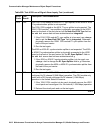
Communication Manager Maintenance-Object Repair Procedures
2408 Maintenance Procedures for Avaya Communication Manager 3.0, Media Gateways and Servers
120A1 CSU Module/Sync Splitter
This test is also used to maintain the 120A1 CSU module or the 401A T1 sync splitter, and the
402A or 403A E1 synchronization splitter. The CSU module, when combined with the
functionality provided by the UDS1 circuit pack, provides functionality equivalent to an external
stand-alone ESF T1 CSU. The combination of the UDS1 and 120A1 CSU module is known as
an Enhanced Integrated CSU (I-CSU).
The 401A T1 synchronization splitter, when combined with the functionality provided by the
UDS1 circuit pack, allows an ATM switch to derive its timing from a T1 connected to the UDS1
in the S8700 Multi-Connect.
The 402A or 403A E1 synchronization splitter, when combined with the functionality provided by
the UDS1 circuit pack, allows an ATM switch to derive its timing from an E1 connected to the
UDS1 in the S8700 Multi-Connect.
If a UDS1 circuit pack detects certain I-CSU/Sync Splitter hardware errors, it notifies the
maintenance software. When the maintenance software receives notification of the I-CSU/Sync
Splitter error, it executes the Loss of Signal Alarm Inquiry test (#138). The test queries for a
Loss of Signal alarm condition, and queries the UDS1 board to confirm the I-CSU/Sync Splitter
error. A Minor or Warning alarm is raised depending on the severity of the I-CSU/Sync Splitter
error. The trunks on the board may be taken out of service if the I-CSU/Sync Splitter error is
deemed serious.
If a Loss Of Signal alarm and an I-CSU/Sync Splitter error coexist, the Loss Of Signal alarm
condition takes priority, and the board and all of its trunks are put in the out-of-service state.
Errors are logged for both.
When the maintenance software receives notification that the I-CSU/Sync Splitter hardware
error condition no longer exists, maintenance restores the board and its trunks to their previous
service state if the alarm can be cleared (no other I-CSU/Sync Splitter errors or Loss Of Signal
alarms exist).
Echo Cancellation
If the TN464GP/TN2464BP or higher suffix UDS1 firmware detects a serious echo canceller
hardware error, it notifies maintenance software. When the maintenance software receives
notification of the echo cancellation error, it executes the Loss Of Signal Alarm Inquiry test.
This test, in addition to querying for a loss-of-signal condition and ICSU errors, also queries the
TN464GP/TN2464BP to confirm the echo canceller error. A minor alarm is raised if the error is
confirmed. The board’s trunks remain in-service since the board is still functional except for its
echo-cancellation capability.
If a loss-of-signal condition coexists with ICSU and/or echo-canceller errors, the loss of signal
condition takes priority, and the board and every trunk on the board is put in the out-of-service
state. Errors are logged, however, for each Error Type.
When the maintenance software receives notification that the echo-canceller hardware’s error
condition no longer exists, the maintenance software restores the board and its trunks to their
previous service state if the alarm can be cleared (no other ICSU errors or loss-of-signal
conditions exist).


















